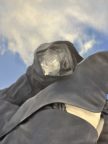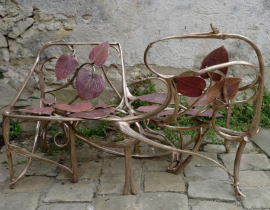On 7 Rue Pastourelle, in Le Marais, the celebrated Suzanne Tarasieve gallery is currently exhibiting the compelling works both of the Algerian born French painter, Youcef Korichi, and the Paris native, Louis Le Kim.
Korichi’s exhibition calls upon the past: his series entitled Le Bleu du Ciel consists of seven large-format paintings, all of which evoke Francisco Goya’s El Pelele, either explicitly by way of replicating Goya’s puppet or, less explicitly, by using only the puppet’s falling body as inspiration. The five paintings, those which are not replications of Goya’s puppet, portray a headless, handless, falling “body” (in quotation marks because this body appears to be simply a suit stuffed with pillows and perhaps other materials, too).
The absurdity of this subject matter is strengthened by the viewer’s narrative ignorance: is this puppet-esque body ascending after having been thrown, like in El Pelele? If it is falling, wherefrom, and onto what? Will it be caught by a circle of laughing women holding a blanket stretched, or will it land on the ground, abandoned? There is nothing in the paintings themselves that would point us towards any definite answers. What is clear, however, is that the pillow-stuffed suit does not seem exist in the same context of a carnival, as the puppet of El Pelele does. And yet, one might approach these paintings precisely as an example of the carnivalesque.
Indeed, modern man’s armour—the suit—is flapping about, flaccidly, in these paintings. This apparent subversion of the suit (i.e. its symbolic relation to power, masculinity, and money) engages a similar reversal of values as Goya’s El Pelele does, in which a circle of women assert their power over a male puppet. Rather than considering gender, however, Korichi’s focus seems to be on modern life at large, or more specifically, perhaps, the working life.
There are various smaller paintings, also part of the Le Bleu du Ciel series, which each in their own way help us to consider the themes of Korichi’s large-format works in different ways. Also by Korichi on view: an intriguing series of paintings using Hans Holbein’s engravings, The Dance of Death, as a model. This second series starkly contrasts the tone of Le Bleu du Ciel, but seems to be nevertheless in conversation with it, insofar as the personified form of death in these paintings adds a sinister atmosphere to the exhibition as a whole, colouring our understanding of the surrounding falling puppets.
On the second floor of Suzanne Tarasieve, one finds the work of Louis Le Kim. Le Kim is drawn to the “underground” and the “barren,” he explained to me—places where time seems to stand still. His drawings and assemblages, all of lifeless landscapes (of structures assembled onto desert backgrounds, abandoned constructions along the beach, or vacant, industrial buildings), highlight for the viewer his affinity for the atemporal, which he seems to regard as that which lacks any human presence. I asked: why choose these specific landscapes as a focus? “The ocean has always been the ocean; the desert has always been the desert”—this was his reply.
Despite Le Kim’s characterisation of his works as engaging the theme of atemporality, I remarked that the pressure of time nevertheless lingers: his works do not simply focus on the natural, but include elements of the human-made, of industrial design. The motif of the industrial, which we could also term the cultural, interacts with the natural scenery in a manner which, one could argue, suggests a certain timeline, a history, a process. How did these structures come to be? Who built them, if anyone, and where have these workers disappeared to? If the oceans and the deserts have for Le Kim a quality of the timeless, should we then approach these built structures contrastingly as time-stamped? Le Kim assured me that his works came to life without any notion of time guiding their creation.
Perhaps, we might understand his works less as conveying a sense of atemporality and more in terms of their portrayal of stillness. These scenes do not necessarily stand without any relation to time, but rather, they proudly keep time at bay. Le Kim’s personal desire to be either alone in his studio, underground below the streets of Paris, or traveling east to visit abandoned power stations, and other such things, parallels this desire for stillness palpable in his art. What I find most striking about Le Kim’s work, however, is the relation it seemingly posits between pristine, prelapsarian landscapes and dystopian, brutalist structures of modernity. What should we make of this, and how might it encourage us to consider differently the spaces we ourselves inhabit? These are the questions that remained for me most prominent after my wonderful conversation with Le Kim.
Youcef Korichi’s Le Blue du Ciel and the works of Louis Le Kim are on view at the Suzanne Tarasieve gallery until the 27th of April.

















